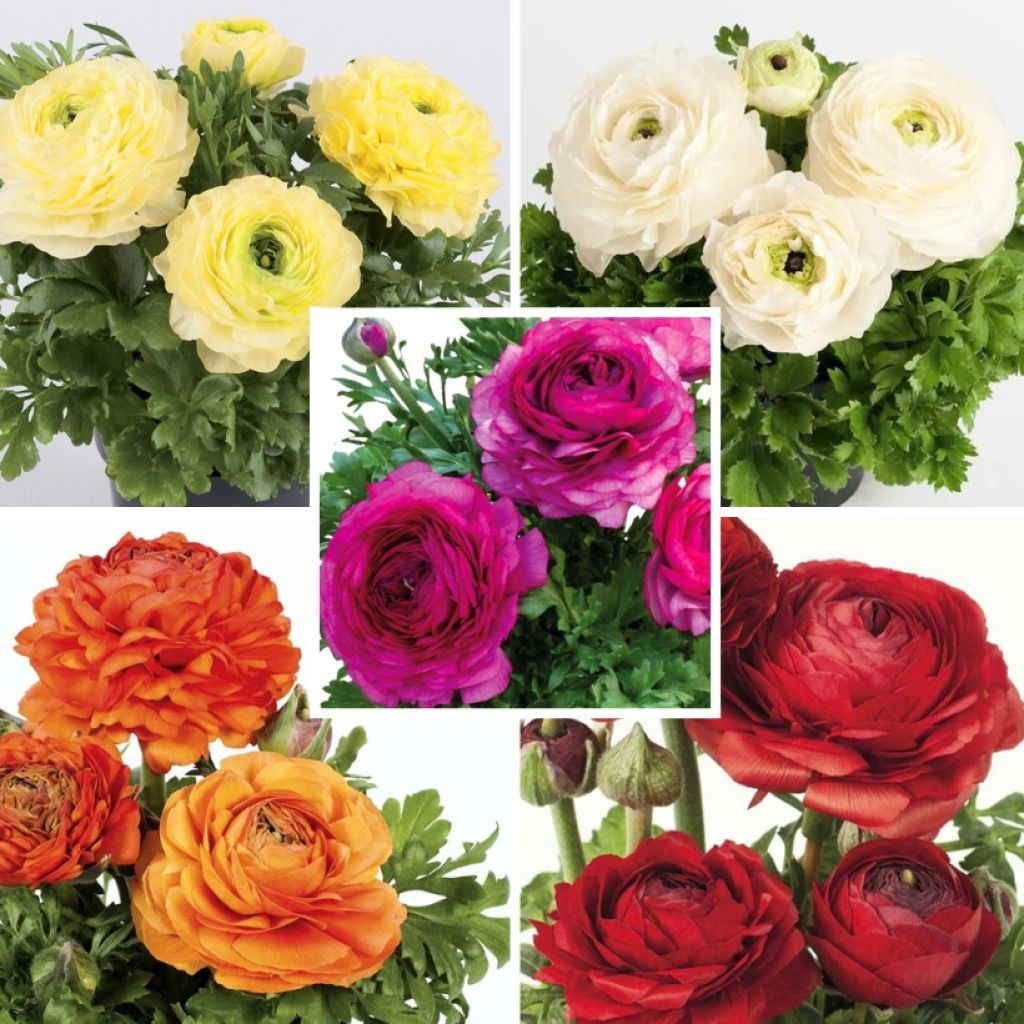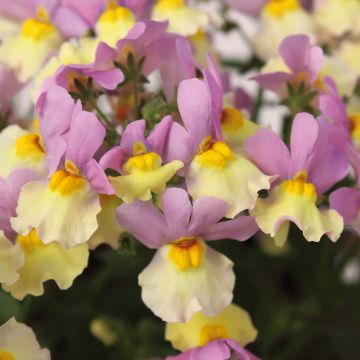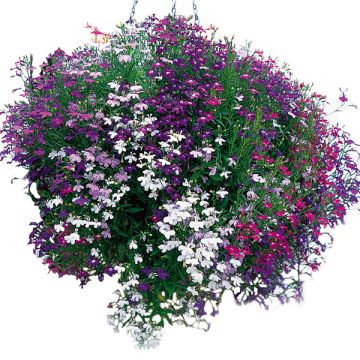

Persian Buttercup Collection
Persian Buttercup Collection
Ranunculus hybrida Vortex F1 White, Vortex F1 Lemonade, Vortex F1 Purple, Vortex F1 Orange, Vortex F1 Red
Ranunculus, Asiatic Ranunculus, Persian Buttercup
Special offer!
Receive a €20 voucher for any order over €90 (excluding delivery costs, credit notes, and plastic-free options)!
1- Add your favorite plants to your cart.
2- Once you have reached €90, confirm your order (you can even choose the delivery date!).
3- As soon as your order is shipped, you will receive an email containing your voucher code, valid for 3 months (90 days).
Your voucher is unique and can only be used once, for any order with a minimum value of €20, excluding delivery costs.
Can be combined with other current offers, non-divisible and non-refundable.
This plant carries a 6 months recovery warranty
More information
We guarantee the quality of our plants for a full growing cycle, and will replace at our expense any plant that fails to recover under normal climatic and planting conditions.
Would this plant suit my garden?
Set up your Plantfit profile →
Collection items (15 plants)
-
Ranunculus hybrida Vortex F1 Lemonade - Persian Buttercup
Price per single item: 4,50 €Find out more
Description
This Collection brings together 5 varieties of Persian Buttercups from the improved Vortex F1 series, of various shades. These are naturally compact plants (20 cm in all directions), well-branched and floriferous, which offer from the end of March to the end of May an abundance of rounded, fully-double and brightly coloured flowers. The Persian Buttercup is a frost-tender, tuberous perennial that is often grown as a biennial, used in flower beds and containers and also excellent for use as a cut flower. It is best planted in autumn, in containers, for early flowering (April-May) or in spring for summer flowering. In regions with mild winters, it can be grown in the open ground. It thrives in partial shade as well as full sun, in rich, loamy soils.
The collection includes:
1 plug plant of Persian Buttercup (Ranunculus) Vortex F1 White : pure white with a black centre
1 plug plant of Persian Buttercup (Ranunculus) Vortex F1 Lemonade : lemon yellow with many different hues and a green heart
1 plug plant of Persian Buttercup (Ranunculus) Vortex F1 Purple : gradient of purple, violet and mauve tones
1 plug plant of Persian Buttercup (Ranunculus) Vortex F1 Orange : dark orange, becoming bright orange
1 plug plant of Persian Buttercup (Ranunculus) Vortex F1 Red : red, with shiny petals
These perennials grow back every year.
Plant Persian Buttercups in partial shade or in a non-scorching, sunny exposure, in fertile, humus-rich soil, ensuring that the growing medium does not dry out too much, without becoming soggy. Use 16 to 20 bulbs per m². Highly ornamental in flower beds or planters, their flowers which can last up to 3 weeks in a vase are popular in floral arrangements alongside roses, Chinese peonies or statices (sea lavenders), for example. In the garden, annual poppies, annual lobelias and nigellas make great companions. By pulling out the tubers in autumn to store them, before the first frosts, you can cultivate this plant like gladioli.
Caution: Please note, our plug plants are professional products reserved for experienced gardeners. Upon receipt, transplant them as quickly as possible, in pots, planters or directly in flower beds.
Report an error about the product description
Flowering
Foliage
Plant habit
Botanical data
Ranunculus
hybrida
Vortex F1 White, Vortex F1 Lemonade, Vortex F1 Purple, Vortex F1 Orange, Vortex F1 Red
Ranunculaceae
Ranunculus, Asiatic Ranunculus, Persian Buttercup
Cultivar or hybrid
Planting and care
Upon receipt, ideally in September, plant these plug plants in a pot or a large container, in a sunny or part shade exposure. They need light, humus-rich soil and appreciate a supply of fertiliser.
Persian Buttercups can be planted in autumn in mild climates or in pots, for early flowering (April-May), or in spring in colder climates for summer flowering. They thrive in partial shade or full sun. Plant them in light, humus-rich and moist soil, preferably enriched with coarse sand. They fear lime-rich soils.
In autumn, lift the tubers and store them in a dry, cool place to protect them from frosts, as they are not fully hardy. Before planting, we advise you to soak the bulbs for half a day. When planting, plant the tubers in a mixture of equal parts garden soil, leaf mould and fairly coarse river sand. These Ranunculus bloom 120 days after planting. Planting density: 16 to 20 bulbs per sqm.
Planting period
Intended location
Care
This item has not been reviewed yet - be the first to leave a review about it.
Similar products
Haven't found what you were looking for?
Hardiness is the lowest winter temperature a plant can endure without suffering serious damage or even dying. However, hardiness is affected by location (a sheltered area, such as a patio), protection (winter cover) and soil type (hardiness is improved by well-drained soil).

Photo Sharing Terms & Conditions
In order to encourage gardeners to interact and share their experiences, Promesse de fleurs offers various media enabling content to be uploaded onto its Site - in particular via the ‘Photo sharing’ module.
The User agrees to refrain from:
- Posting any content that is illegal, prejudicial, insulting, racist, inciteful to hatred, revisionist, contrary to public decency, that infringes on privacy or on the privacy rights of third parties, in particular the publicity rights of persons and goods, intellectual property rights, or the right to privacy.
- Submitting content on behalf of a third party;
- Impersonate the identity of a third party and/or publish any personal information about a third party;
In general, the User undertakes to refrain from any unethical behaviour.
All Content (in particular text, comments, files, images, photos, videos, creative works, etc.), which may be subject to property or intellectual property rights, image or other private rights, shall remain the property of the User, subject to the limited rights granted by the terms of the licence granted by Promesse de fleurs as stated below. Users are at liberty to publish or not to publish such Content on the Site, notably via the ‘Photo Sharing’ facility, and accept that this Content shall be made public and freely accessible, notably on the Internet.
Users further acknowledge, undertake to have ,and guarantee that they hold all necessary rights and permissions to publish such material on the Site, in particular with regard to the legislation in force pertaining to any privacy, property, intellectual property, image, or contractual rights, or rights of any other nature. By publishing such Content on the Site, Users acknowledge accepting full liability as publishers of the Content within the meaning of the law, and grant Promesse de fleurs, free of charge, an inclusive, worldwide licence for the said Content for the entire duration of its publication, including all reproduction, representation, up/downloading, displaying, performing, transmission, and storage rights.
Users also grant permission for their name to be linked to the Content and accept that this link may not always be made available.
By engaging in posting material, Users consent to their Content becoming automatically accessible on the Internet, in particular on other sites and/or blogs and/or web pages of the Promesse de fleurs site, including in particular social pages and the Promesse de fleurs catalogue.
Users may secure the removal of entrusted content free of charge by issuing a simple request via our contact form.
The flowering period indicated on our website applies to countries and regions located in USDA zone 8 (France, the United Kingdom, Ireland, the Netherlands, etc.)
It will vary according to where you live:
- In zones 9 to 10 (Italy, Spain, Greece, etc.), flowering will occur about 2 to 4 weeks earlier.
- In zones 6 to 7 (Germany, Poland, Slovenia, and lower mountainous regions), flowering will be delayed by 2 to 3 weeks.
- In zone 5 (Central Europe, Scandinavia), blooming will be delayed by 3 to 5 weeks.
In temperate climates, pruning of spring-flowering shrubs (forsythia, spireas, etc.) should be done just after flowering.
Pruning of summer-flowering shrubs (Indian Lilac, Perovskia, etc.) can be done in winter or spring.
In cold regions as well as with frost-sensitive plants, avoid pruning too early when severe frosts may still occur.
The planting period indicated on our website applies to countries and regions located in USDA zone 8 (France, United Kingdom, Ireland, Netherlands).
It will vary according to where you live:
- In Mediterranean zones (Marseille, Madrid, Milan, etc.), autumn and winter are the best planting periods.
- In continental zones (Strasbourg, Munich, Vienna, etc.), delay planting by 2 to 3 weeks in spring and bring it forward by 2 to 4 weeks in autumn.
- In mountainous regions (the Alps, Pyrenees, Carpathians, etc.), it is best to plant in late spring (May-June) or late summer (August-September).
The harvesting period indicated on our website applies to countries and regions in USDA zone 8 (France, England, Ireland, the Netherlands).
In colder areas (Scandinavia, Poland, Austria...) fruit and vegetable harvests are likely to be delayed by 3-4 weeks.
In warmer areas (Italy, Spain, Greece, etc.), harvesting will probably take place earlier, depending on weather conditions.
The sowing periods indicated on our website apply to countries and regions within USDA Zone 8 (France, UK, Ireland, Netherlands).
In colder areas (Scandinavia, Poland, Austria...), delay any outdoor sowing by 3-4 weeks, or sow under glass.
In warmer climes (Italy, Spain, Greece, etc.), bring outdoor sowing forward by a few weeks.














































